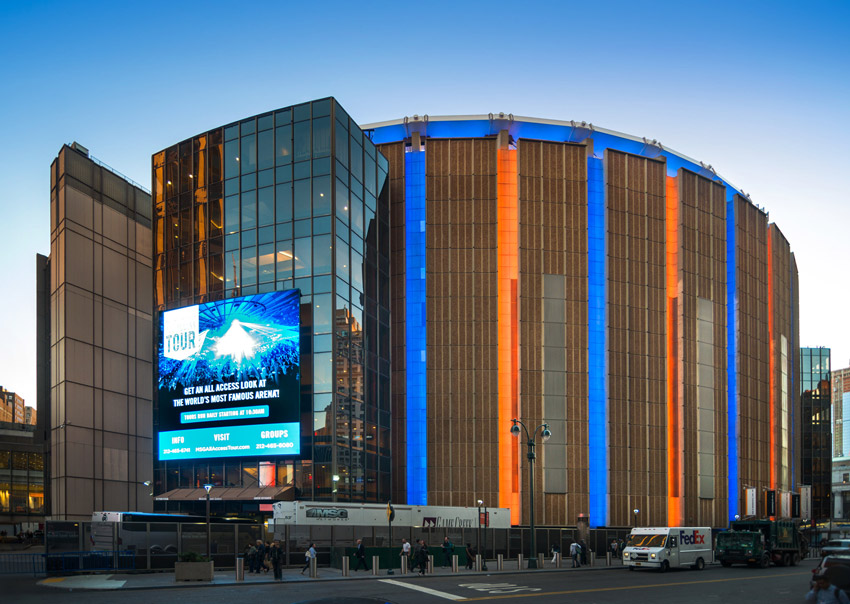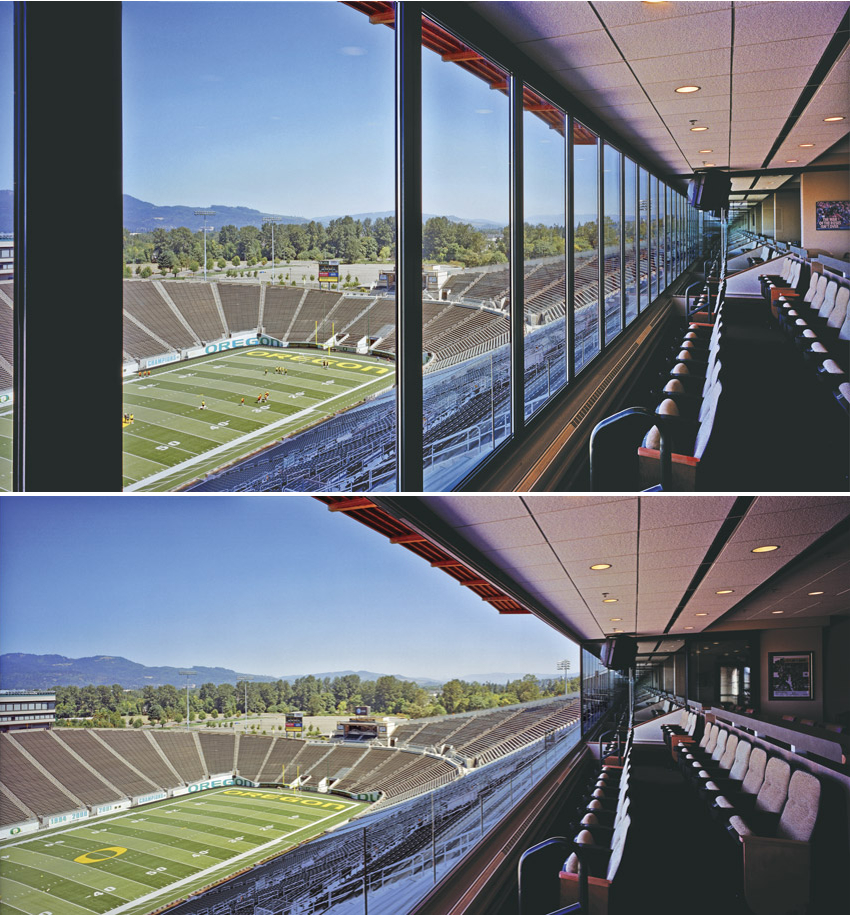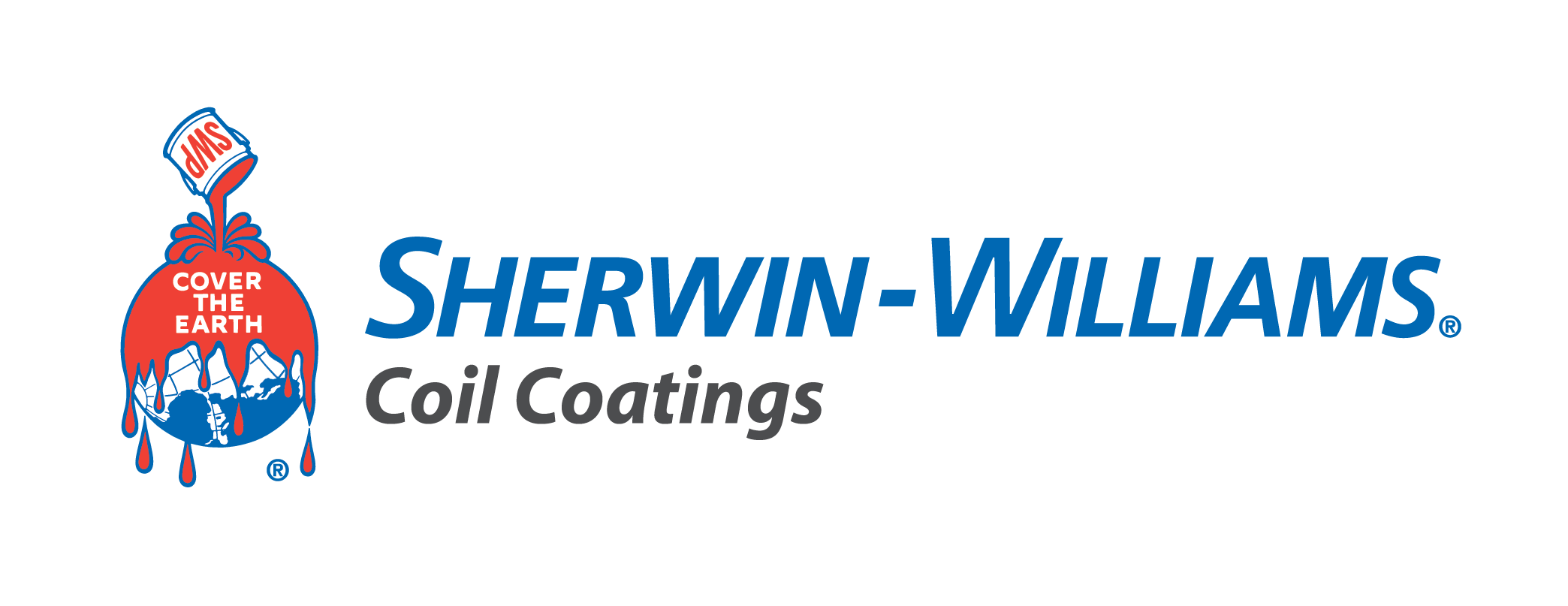Winning Stadium Designs
Design and performance team up for the best project solutions
![]() Continuing Education
Continuing Education
Use the following learning objectives to focus your study while reading this month’s Continuing Education article.
Learning Objectives - After reading this article, you will be able to:
- Identify the significance of large-scale and component elements of a stadium exterior design.
- Assess the importance of durability, style, health, and safety for interior spaces in a stadium, including common areas and locker rooms.
- Explain the importance of proper attention to details for the performance of critical design components, such as operable glass walls.
- Determine ways to apply the principles as presented into building projects demonstrated through case-study projects.
Stadiums continue to garner attention around the world as new ones are proposed, funded, designed, constructed, and operated. Meanwhile, existing ones are renovated and/or expanded in order to keep up with the emerging trends in state-of-the-art sports and entertainment venues. Many are associated with college or professional sports teams, but they also seek more hours of usage by attracting musical, entertainment, and local school events to use their facilities. Thus, they are truly multipurpose, multi-venue, and multi-user community assets. All of these appealing but complex variables mean that design professionals have a lot to consider when working on any of these facilities. Whether for a small community facility of 10 to 20 thousand square feet or large facilities in excess of a million square feet, all of them have to meet some basic requirements for design, construction, and smooth operation. We will take a look at some of those needs in this course.
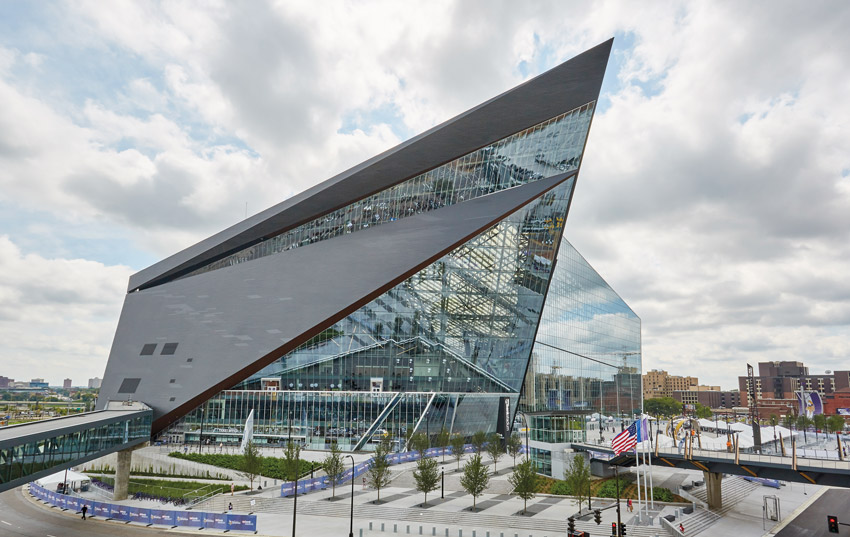
Photo courtesy of Construction Specialties
Stadiums serve many needs in a community and in the process need to accommodate many different design needs.
Shown: U.S. Bank Stadium in Minneapolis, home of the Minnesota Vikings football team and the 2018 Super Bowl
Exterior Design
A stadium is often known by its exterior appearance. Many people who never step foot inside will still experience it from the outside either in person as part of the community where it is located or in the media as its image is projected across the country or around the world. It is not surprising then that architects spend a good deal of design effort on this very visible aspect of such facilities, both in terms of expressed form and exterior finish materials. The form can respond to its surroundings, stand in contrast, or reflect the seating and field shape of the facility, all as determined by the design process.
The materials used on the exterior of a stadium are often chosen directly in concert with the form and statement being pursued. Those materials need to not only project the design intent but also provide long-term durability and economy both in terms of initial costs and maintenance costs. Toward that end, exterior design elements such as facade panels, roofing, curtain walls, and louvers commonly use factory-applied metal coatings to enhance design impact. Coatings are used to both protect the base steel and aluminum as well as offer virtually unlimited aesthetic variation. Careful consideration must be given to the selection and specification of the appropriate coating system to ensure it stands up over time. In that regard, factory-applied fluoropolymer coatings have become an industry standard providing durability and design flexibility. These well-known coatings have been in use in buildings for more than 50 years and have proven themselves in the marketplace as a resilient finish that is quite suitable for long-lasting monumental buildings like stadiums.
Fluoropolymer, high-performance coating systems are factory applied for high-quality control and consistency of the finish. There are essentially two types of resins that are used in these coatings. The first is polyvinylidene fluoride, commonly referred to as PVDF. Commonly used for monumental and commercial projects, it is usually formulated with a ratio of 70 percent PVDF resins and 30 percent other materials. It is a factory-applied, baked-on finish using a high heat process to cure the coating system. The second option is fluoroethylene vinyl ether, referred to as FEVE coatings. These offer a wider range of gloss levels from matte to high gloss and can achieve brighter, more vibrant, and higher-impact colors than PVDF. Both of these choices offer nearly unlimited options since they can be matched to any color (solid or metallic). They are also available with unique aesthetic effects like color shifting, high sparkle, and even prints that mimic other building materials, such as natural and weathered metals, wood, or stone. For any of these, there are choices in terms of gloss or matte finish and variations.
An important consideration for the architectural appearance on a building is batch-to-batch color consistency of the materials being coated. When working on a stadium project, the size may dictate an extended construction schedule such that the coating process is taking place on products spanning over months or even years. In that regard, it’s important to identify and work with a manufacturer that offers batch-to-batch color consistency. This helps avoid panels that are mismatched—especially for metallic colors that can have a directionality to them. Properly selected and produced coatings can offer greater color consistency compared to natural and anodized metals, often with a price advantage as well.
Jeff Alexander is the vice president of sales for Sherwin-Williams Coil Coatings and observes, “We commonly see architects specify 70 percent PVDF and FEVE coating systems on stadium facades not only for their lasting durability and color retention but also because they are able to achieve such a wide range of aesthetic looks. Metal wall panels coated with 70 percent PVDF and FEVE coatings create a bold design statement for building exteriors, whether you’re looking to incorporate team colors into your design or draw from a more classic color palette.” Clearly, they are an option worth considering.
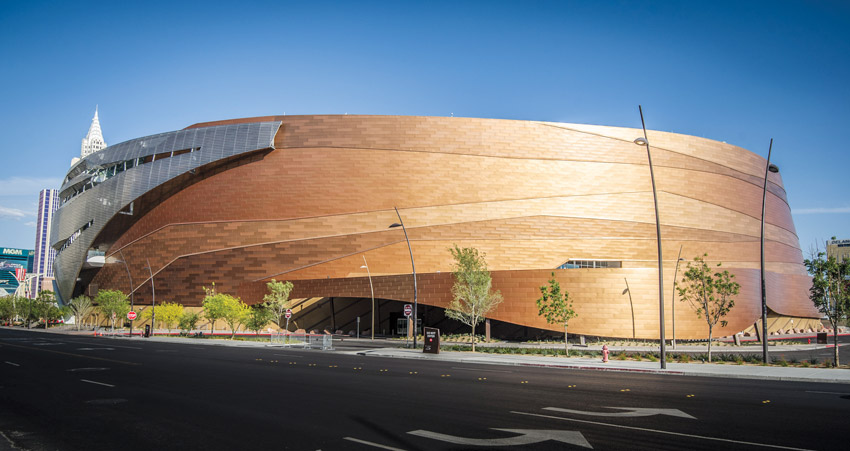
Photo courtesy of Sherwin-Williams
Fluoropolymer coatings can be used on metal building products to provide a very durable, long-lasting finish in a wide variety of design options to create distinct exterior aesthetics, such as at the T-Mobile Center in Las Vegas.
Exterior Specialties
The large expanse of the exterior of a stadium can have many smaller areas and details that need to be addressed. For example, there may be enclosed viewing areas or windowed parts of the facility that can benefit from sun control systems that can lower energy costs and reduce glare but still allow filtered light to enter. Beyond these performance benefits, they can also help create a unique architectural design by providing intricate patterns, sleek textures, and vivid colors or even incorporating LED lighting.
Another common exterior specialty for stadiums is the incorporation of metal louvers that may be needed for general building ventilation or HVAC equipment purposes. In order to be considered high performance, such louvers need to meet some rigorous design and testing requirements to assure that the amount of air-flow through a louver can be met while at the same time providing resistance to weather or even storms. These performance requirements not only apply to the body of the louvered area itself, but also to the seams and joints between louver components, adjacent louvers, or louvers and adjacent wall facades. While some louvers can be specified as off-the-shelf items that have been independently tested by Air Movement and Control Association(AMCA), many louver systems are custom designed to fit unique stadium situations. That means their performance should likewise be tested in accordance with published standards. Working with a manufacturer who can arrange such testing capabilities for custom products can be important to success. Whether the performance criteria is for high-performing extreme weather louvers, storm-resistant louvers (tested for wind driven rain), or drainable and standard non-draining louvers, having tested performance data is paramount.
From a design standpoint, louvers can be designed to integrate into any high-performance facade. Visually, they can be used as an architectural element that provides an accent, or they can blend into an overall look of the building. Some manufacturers offer options such as design profiles that allow customization of the louver color and customized appearance with accent features, geometric grilles, and even a louver hidden by perforated sheet. Accessories can be added as well such as bird screen, insulated panels (that can be used to block off all or a portion of a louver), and even LED lights.
It is the combination of high performance and the options for the architectural look of louvers that allows them to work in complex stadium designs. Eric Sposito, CDT, is general sales manager at Construction Specialties and notes, “High-performance louvers allow architects to defy traditional airflow design conventions in order to achieve their true vision without sacrificing performance.”
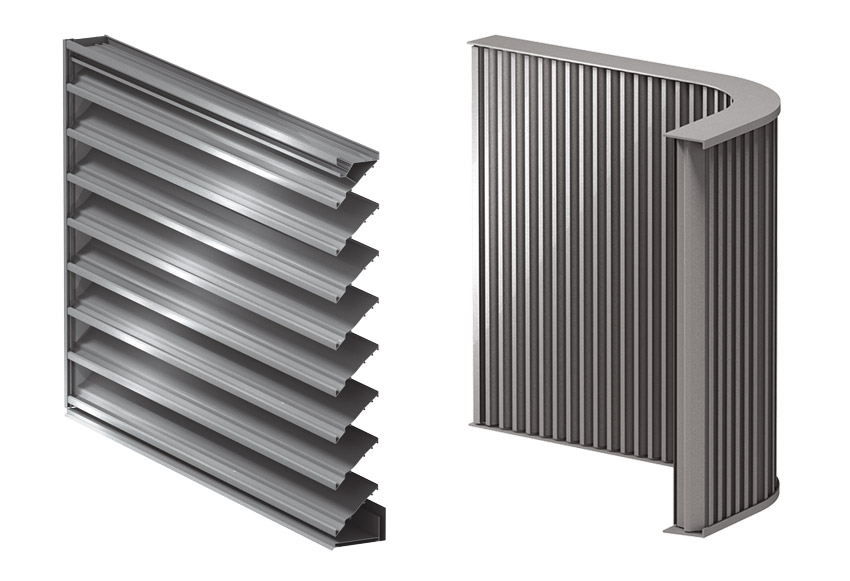
Images courtesy of Construction Specialties
High-performance louvers can be customized and incorporated into a stadium facade to provide the needed airflow and weather-resistant performance as well as aesthetic solutions for an exterior design.
Opening Glass Walls For Flexibility
As a multiuse facility, stadiums need to accommodate a range of group sizes and a variety of users. Some prefer, and are willing to pay for, gathering in small groups rather than being part of the crowd, and they may be looking for more amenities than open seating can offer. Hence the growth of private or shared boxes with protected or even enclosed spaces and services has become widespread. Similarly, restaurant and bar areas in stadiums seek the same ability to operate smoothly regardless of the weather and be alternately open to the public or closed and secure. The design challenge becomes how to meet these seemingly competing needs as part of the overall stadium design. One proven solution is the use of opening glass walls that can slide or fold completely out of view when open while being able to provide views but resist weather and lock tight when closed.
The flexible operability of opening glass walls enable suites, gathering areas, in-stadiumw restaurants, or bars all to have the ability to configure the space based on the needs of the occupants or the event. For instance, when the glass wall is open, the fans experience the crowd directly, but when closed, the operable glass wall provide a transparent barrier with unobstructed viewing. In cases where the playing field is outdoors, the closed wall also provides greater human comfort with protection from wind, cold air, and noise. Further, when there are no events taking place or in the off-season, the weather-resistant opening glass walls protect interior spaces and furnishings from exposure and/or unauthorized entry.
There are numerous benefits for stadium owners/operator who incorporate opening glass walls and flexible spaces into the design. In many cases, they can command higher ticket prices or permanent seat license (PSL) rates by providing suites that offer a unique experience for the fan, allowing the occupant the choice to open or close the glass panels with ease. Multiple uses and configurations of spaces mean the stadium isn’t limited to an all-or-nothing rental facility. That can mean continuous sources of revenue coming in from various types and sizes of events. By using opening glass walls, separate interior spaces can be created, distinguishing flexible suites from standard luxury boxes and thereby offering a variety of choice and price levels. In the end, it is the spectator/user that benefits from an enhanced experience and more opportunities to find a setting to meet their needs.
From a performance perspective, opening glass walls are available in wood- or aluminum-framed systems or frameless all-glass opening glass systems. The framed systems can be large full-door heights spanning unlimited widths, while the frameless opening glass walls offer an all-glass, no-profile panel for maximum view. Depending on the specifics of the particular system, the openings can range in width from as little as 9 feet wide up to as much as 300 feet or more. They are typically comprised of uniformly sized panels with a top and bottom track along which the doors either fold or slide. With the glass panels open during pleasant weather, they can allow fresh air and connection to the outdoor event area. When the panels are closed, however, they need to create a secure, weather-resistant barrier that protects against rain, snow, humidity, noise, and extreme temperatures. Because of the typically large opening sizes, the corresponding large perimeter area, and multiple joints between panel sections, the ability to seal tightly along all of these locations when closed is important. Therefore, most manufacturers will have their products independently tested to assure that they meet standard criteria for these environmental and security conditions.
From an operational standpoint, the glass panels need to easily glide or fold into position, meaning that the mounting and tracking mechanisms must be proven and reliable. Those can be similarly tested and documented for their performance, but finding a system that is easy to use and fairly intuitive will make it easy for stadium staff or even the general public to operate the panels.
The manufacture and production of operable glass wall systems can certainly vary between suppliers since they require considerable diligence and attention to detail in order achieve high-performance levels. Hence, it is incumbent on specifiers to request independent testing reports on the selected products to determine the results for thermal performance, penetration of wind or water, security, and acoustical characteristics. This stringent and thorough third-party testing ensures optimum performance for specific site conditions. It also means that interior separation of spaces between several smaller groups is effective and does not compromise users in either space.

Photos courtesy of NanaWall Systems
Opening glass walls used in stadiums, such as the Target Center shown here, create flexibility in space usage by functioning in either the closed or open positions, all in a durable and transparent manner.
Protecting Interior Surfaces With Style
All stadium interior spaces that encounter heavy pedestrian and equipment traffic are subject to wall damage. Incorporating wall and corner protection within interior spaces provides more resiliency and time savings for maintenance teams who are challenged with keeping the walls free from scuffs and damage that requires constant attention and repairs. Relying on a maintenance team to address the damage after it occurs can be costly, not to mention disruptive to operations, so it makes sense to look for an alternative in the form of a wall-protection system. These systems are applied to wall substrates and are often manufactured as durable sheet products that come in a variety of thicknesses, most commonly 0.040 inch, 0.060 inch, and 0.075 inch to accommodate different wall conditions and help resist damage from day-to-day use and abuse. Similarly, corner guards can be installed that resist the potential for damage there. Different types are available, including 16 gauge/304 alloy stainless steel sheet for high durability. All of these measures keep the interior of the facility looking as good as it did on opening day, usually for many years down the road. Incorporating resistance to physical abuse reduces the need for maintenance dramatically, making these products a logical choice for designers and building owners alike by eliminating the need for repainting, resurfacing, or repairing unprotected surfaces.
It is worth pointing out that such protection need not be limited just to walls. Rather, doors in a stadium can be selected that have an impact-resistant fabrication and are covered with the same type of sheet products used on walls. This can be particularly helpful in creating durable door solutions for restrooms, janitorial closets, clubhouse entries, and many other high-traffic areas throughout a stadium concourse. The makeup of such doors can meet fire-rating requirements and help extend the service life of the door, making it a very economical solution over the long haul.
Whether used for walls, doors, or both, protective products offer abundant design options and color choices that can create accents or blend into any interior space. A wide range of solid colors, patterns, and simulated wood or metals are available. There are even sought-after options that allow artwork to be installed behind a clear protective sheet and mounted onto a wall or door. Photographs, logos, patterns, or custom artwork can be reverse-printed behind clear rigid sheet, serving as a protective shield for the design while providing impact-resistant protection to the surface below.
Overall, surface protection products offer a highly durable, long-term wall-protection solution that stands up to years of abuse while offering a range of design options appropriate for utility spaces to board rooms and just about everything in between. Renee Hite is the assistant business development manager for Acrovyn by Construction Specialties, and she comments on this type of protective product: “The resiliency, abundant design options and color choices can add style or blend into any interior space, all while offering protection needed in high-traffic interior building spaces.”
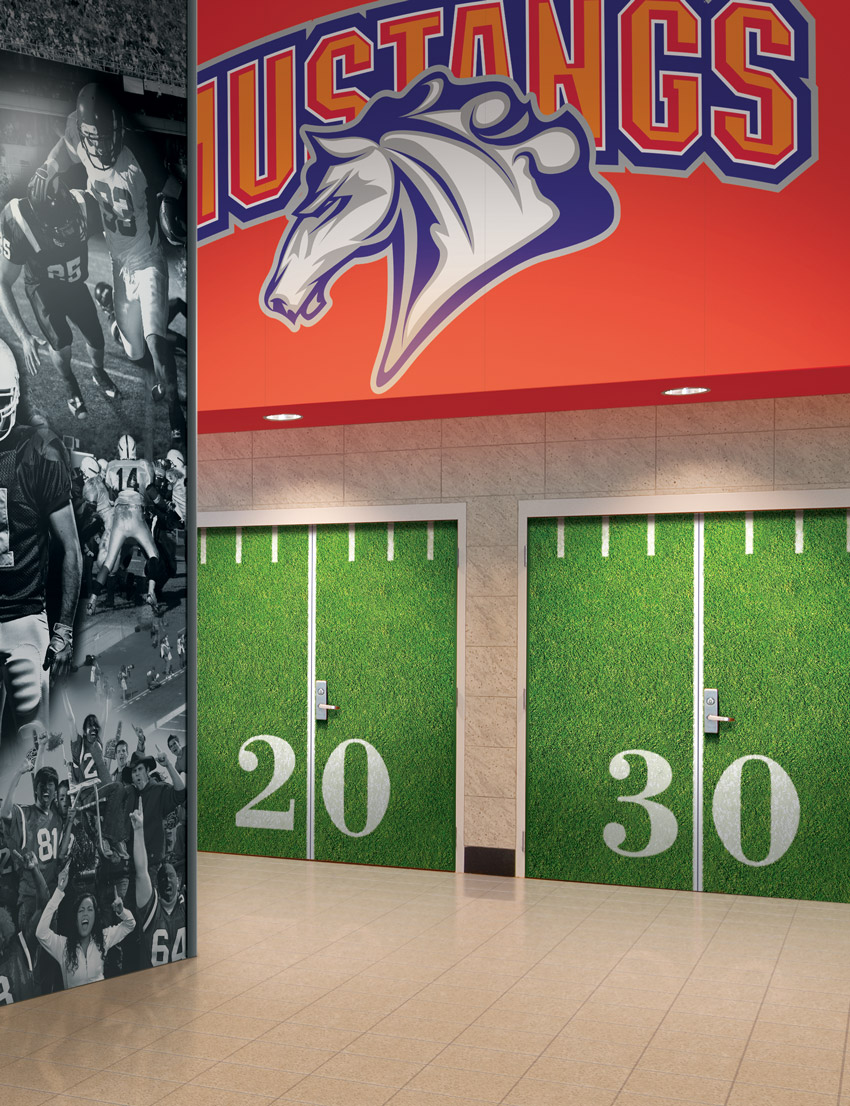
Photo courtesy of Construction Specialties
Interior wall surfaces and doors in stadiums can be subject to a lot of use and abuse. Incorporating protective surfacing products over walls and doors can provide the needed durability while offering color and design options as well.
Specialty Products
Stadium design requires attention to detail, and that often translates into the use of specialty products to address some specific needs. Of course those specialties also need to work with the overall design of a stadium.
Expansion Joint Systems
With their sheer size and surface area, stadiums are subject to significant movement of floors, walls and roof areas from thermal or other environmental forces. Therefore, expansion joint systems are a necessary component that must be engineered to handle not only movement but address several other factors too. First is the need for high durability of the joint materials and covers to withstand pedestrian traffic, push carts, scissor lifts, etc. Another factor is the ability to act as a moisture barrier since expansion joints in exterior walls or roofs must prevent rainwater infiltration or help channel rainwater to drainage points. Finally, if the expansion joint is in a fire-rated assembly, then the joint needs to be fire rated as well. Since wet fire barriers can become worthless and dangerous, preventing water from entering a fire barrier is critical to life safety. In that regard, choosing a supplier for expansion joint systems and fire barriers that are truly effective cannot be overstressed.
When looking at expansion joint system selection and specification for stadiums and arenas, several things need to be considered. First is the nominal joint size compared to the range of movement between the minimum fully contracted size and the maximum fully expanded size. The expansion joint system selected needs to accommodate this full movement range. Second is recognizing that building sections can move due to a variety of reasons, including one-directional thermal movement, multidirectional seismic movement, or movement along the joint as in wind-load induced movement. Third is loading requirement, referring to the type of weight and actions that will be induced onto the joint system, including its cover, during building occupancy. Fourth, is continuity of the expansion joints. Since a project scope could include interior and exterior joints or both, the joints need to run continuously through all adjacent planes to fully separate building sections and allow independent movement in things like building veneers, soffits, parking decks, patios, roofing systems, etc. Fifth is attention to fire resistance and moisture control since expansion joints may interrupt building assemblies that need to maintain one or both of these traits while still allowing the appropriate movement to occur. Finally, the form and appearance of expansion joints should be addressed so that it works with the design scheme of the adjacent finishes. With these considerations taken into account, the selection of expansion-joint systems can be worked into specifications and construction drawings to help assure stadiums are properly allowed to move, remain weather and moisture tight, and protect life safety.
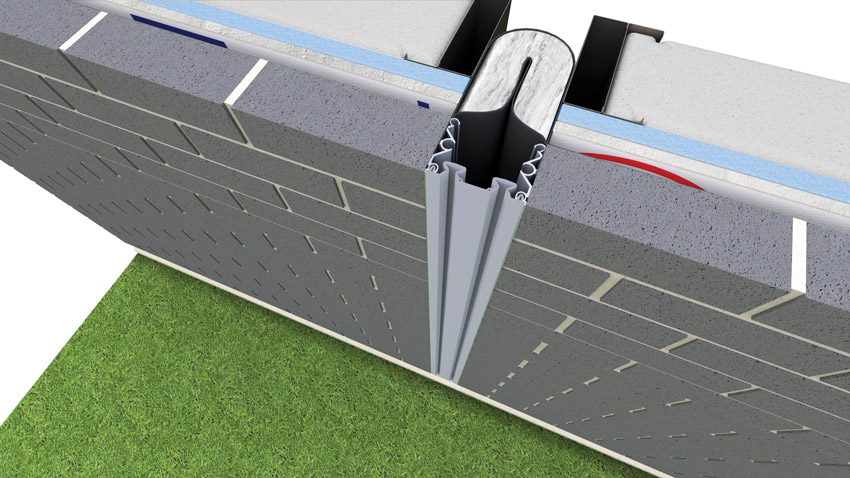
Image courtesy of Inpro
Properly designed expansion-joint systems are continuous across all planes of a structure and take into account the differing conditions in different locations.
Large-Scale Graphics
Incorporating standard or customized artwork into a stadium is often desirable for a lot of reasons. These could include creating decorative wall panels, facility branding, storytelling, timelines, lobby displays, informational displays, wayfinding, or as a means to provide a connection with teams or the community. Of course, incorporating such art can be expensive, not to mention easily vandalized or damaged. In order to provide protection but keep the art fully visible, there are systems available that allow art to be printed and combined with a protective covering. The sizes of such protective wall art systems come in a variety of standard sizes and custom sizes are possible too. Mounting options include stand-off style, screwed in place, adhesive, or cabled.
Manufacturers of such systems promote unlimited colors and design options to help create a custom look and fit for any facility. Any image can be used (provided proper reproduction authorization is obtained) and printed in a variety of formats.
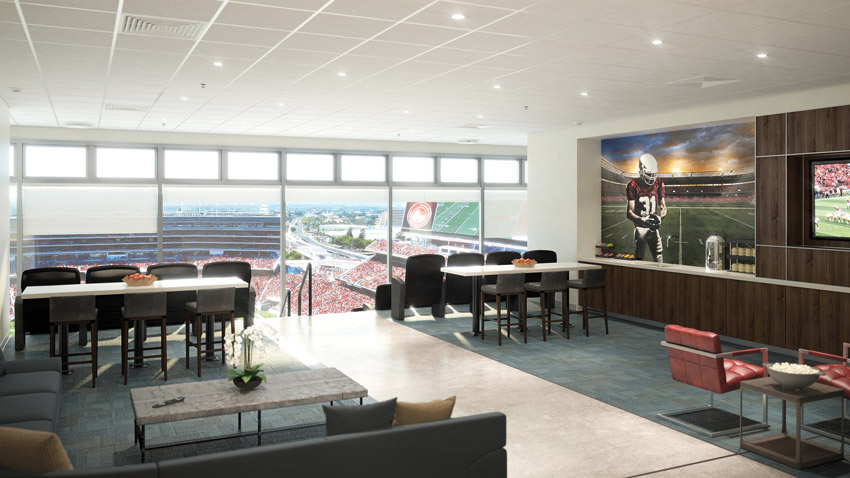
Photo courtesy of Inpro
Large-scale graphics can enhance the stadium experience for fans, guests, and patrons by incorporating standard or custom imagery into the interior design of selected spaces.
Locker Room Showers
Stadiums typically contain high-quality locker rooms and showers for the home and visiting teams. That quality is needed not only for the high-end appearance that may be expected but also for durability and ease of maintenance. Shower stalls, in particular, raise questions about the most suitable material to use in order to meet these needs. Many have assumed that ceramic tile is a good choice since the glazed surface of the tile can be appealing, is easy to clean, and provides good hygienic properties. However, the grout lines in between the tiles can quickly become problematic, allowing mold, mildew, cracks, and water penetration to occur. That all adds up to ongoing maintenance demands at best and very unsightly conditions or building damage at worst.
A preferred alternative is to use solid-surface panels to provide an excellent shower enclosure, including the shower base pan. Since the panels can be designed and sized to fit fully in a shower, there are no or minimal joint lines. Further, solid surface is non-nutritive, meaning it does not promote the growth of mold and mildew and resists bacterial growth. The inclusion of active antimicrobials like copper within the solid surface itself can reduce odor-causing bacteria. During construction, solid surface showers can mean quicker turnaround on installation over traditional tile. From start to cured finish, solid surface showers can be ready to use in as little as four to five days. Traditional tile can take up to 12 days by the time all steps are finished, including mortar bed prep and curing, grouting and curing, and finish seal cure.
A common misconception among designers and contractors is that shower receptors must always have the drain in the dead center of the receptor. That is simply not true. Being able to put the drain hole in virtually any position is a distinct benefit of solid-surface shower receptors that are made in a manufacturing plant and can be sloped according to project specific needs, including accessibility requirements. Solid surface receptors can also be installed in as little as 1 hour versus a tile pan that can take up to three days to finish.
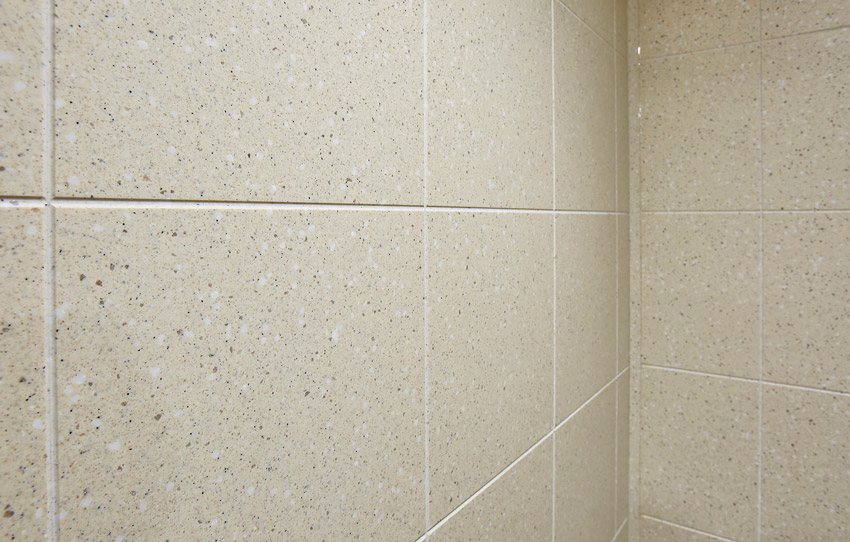
Photo courtesy of Inpro
Team lockers and showers made from solid-surface material, like the example shown here, can provide a superior appearance with multiple finish options, be easier to clean and maintain than tile, and provide durable surfaces on all sides, including the drain pan.
High-Speed, High-Performance Doors
There are plenty of things that need to move around in a stadium besides people. Equipment, supplies, seating, and the machinery to move all of that are common so that food service can be provided, stages can be set up and taken down, and sports teams can function. All of this not only means that corridors and passageways need to be designed to handle these back-of-house functions, but it also means that appropriate doors need to be used to access the spaces off of those passageways. In some cases, an alternative to swinging doors is sought so that forklifts, carts, or other equipment can pass through without fear of damaging the doors, meaning that the doors roll up or slide out of the way. It also means that the doors need to be able to open and close automatically so the equipment operators don’t need to stop to perform that function.
One of the best responses to these door needs is to use high-speed automatic doors. According to the Door and Access Systems Manufacturers Association (DASMA), high-speed doors are a subcategory type of high-performance doors. They are power-operated, coiling, folding, or sliding non-residential doors, generally characterized by high cycle-ability (75–100 or more opening and closing cycles per day) and/or rapid operating speed (32–40 inches per second or more). Several types fit into this category, including fabric panel rolling doors, rigid panel rolling doors, folding doors, and sliding doors. They are typically made to order for high durability and/or designed to safely break away due to equipment impact. These types of high-performance doors offer unique enhancements not available with conventional coiling and sectional overhead doors, including operational cost savings, energy efficiency, and the ability to sustain high usage with minimal maintenance. As such, they are ideally suited to many stadium installations.
DASMA’s High-Performance Door Division has presented findings of a two-year research effort involving third-party laboratory testing and summarized it in a DASMA article titled “When a High-Speed Door Is More Energy Efficient.” The study demonstrates that if a doorway is used frequently, at or above 55 cycles per day, a high-speed door delivers superior traffic flow and conditioned air conservation as compared to conventional overhead coiling doors. Prior to this work, high-performance doors were only considered in building codes and standards as static, and closed. However, because of this research, codes now recognize the dynamic nature of these high-performance doors. In particular, high-speed doors offer a unique benefit in controlling air exchange. When other slower-moving doors are activated, the amount of air exchange is high because the door is fully open for a longer period of time. High-speed doors open and close faster so the air exchange between each side is reduced. That can improve energy performance in a building, especially when the door is opened and closed frequently each day. Using the methods described by DASMA, it is now possible to demonstrate calculated energy performance and cost savings on a building envelope in a reliable and verified way.
In the United States, high-performance doors and their components are often engineered to meet material and assembly performance criteria as set forth by well-known standards and testing agencies such as ANSI, ASTM, IEC, and UL. High-performance doors may also need to comply with building codes and standards applicable to stadiums as places of assembly. In recent years, the definition of high-speed doors has been added to ASHRAE 90.1-2013, ASHRAE 189.1-2013, and the 2105 International Energy Conservation Code (IECC). In addition, associations such as DASMA and the National Fenestration Rating Council (NFRC) are involved with developing industry standards specifically for high-performance, high-speed doors.
High-speed, high-performance doors have been available for more than 35 years, primarily installed at industrial locations. Now, high-performance door manufacturers are seeing a rapid surge in product popularity within more visible commercial venues such as stadiums. This is due to the product’s ability to enhance thermal performance and energy efficiency for exterior applications or between conditioned space and refrigerated space. Manufacturers are also responding to some emerging trends by offering greater thru-visibility qualities with clear vision panels, higher operating speeds, enhanced safety features, and more compact designs. Overall, high-performance, high-speed automatic doors have come to be recognized for providing functional and operational solutions for client operations with contemporary aesthetic features and options with minimal maintenance as compared to traditional rolling doors.
When designing with and specifying high-performance, high-speed doors, architects should consider the following:
- Project type: Are the doors being used for new construction or retrofit/replacement, and what are the parameters of the new or existing walls where they will be located?
- Application: Are the doors being used purely to separate conditioned interior spaces, or are there special concerns such as between parking garages, food and beverage spaces, freezer spaces, tunnel areas, or other demanding locations?
- Aesthetics: What are the appearance and design qualities being sought?
- Desired speeds: Opening speeds can be identified, typically 32 inches per second or more. Closing speeds are sometimes just a little slower for safety but no less than 24 inches per second.
- Type and speeds of thru-traffic: Doors can be specifically selected and designed to accommodate automobiles, forklifts, or other equipment as well as pedestrians. An understanding of the primary users of the door can help define cycle volumes and durability requirements.
- Thermal performance: If this is required, then the specific requirements should be identified for both insulation value and air infiltration.
- Wind resistance: If the door is subject to exterior or interior wind pressures, that can be accounted for in the door design to resist it appropriately.
- Type of door curtain: Rigid or flexible materials are available with the ultimate choice possibly being impacted by security needs or other considerations.
- Control panel: Different technologies for door control are possible, including integration with building networks and smart devices.
- Space requirements: Compared to other door types, high-speed, high-performance doors usually free up floor space along with well-defined opening sizes with minimized side-jamb and headroom fitting clearances.
- Approach distances: These can be defined using different types of activation equipment, such as security card activators, laser motion and presence sensing, manual push button, ground induction loop, and others.
- Special door panel requirements: Different options are available, including insulated solid, non-insulated vision, perforated ventilation (for open-air requirements), or other choices.
- Available building power supply: The door will usually require a three-phase electric power source. The coordination of phase and voltage requirements needs to be addressed.
- Sustainability goals: High-speed, high-performance doors commonly produce favorable life-cycle and costing benefits.
- Maintenance requirements: Check the manufacturer’s owner’s manual for recommended maintenance, such as cleaning the door curtain/vision area and visual inspection of the overall appearance.
- Manufacturer’s warranties: Most quality doors are available with warranties and other quality commitments.
High-performance doors have been used successfully in many demanding situations beyond stadiums too. Bob Rombs is vice president for the Audi Hampton car dealership and notes, “It’s really nice to hear our clients come in—they’re very impressed. The high-performance doors exceed our standards and are aesthetically pleasing.” Similarly, Herc Meier is chief of the Fulshear Simonton Fire Department and observes, “My family and I drive by this station many times. The aesthetics of the doors with our equipment standing behind there telling our community that we’re ready to respond and allowing them to see what their tax money goes to has been great for us.”

Photos courtesy of Hörmann High Performance Doors
High-speed, high-performance doors can provide a durable, efficient, and economical solution to many large opening needs.
Conclusion
Stadiums require attention to design as well as to durability, versatility, and multiple user needs. This is true in the exterior design, specialties, interior finishes, doors, and even the locker rooms. Properly addressing all of these areas can contribute to iconic appearances that will hold up over time, providing users and owners a favorable long-term experience.
Peter J. Arsenault, FAIA, NCARB, LEED AP, is a nationally known architect, consultant, continuing education presenter, and prolific author advancing building performance through better design. www.pjaarch.com, www.linkedin.com/in/pjaarch


